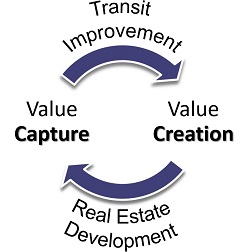Value Capture
Overview
Value capture strategies generate sustainable, long-term revenue streams that can help repay debt used to finance the upfront costs of building infrastructure, such as transit projects. Revenue from value capture strategies can also be used to fund the operations and maintenance costs of transit systems.
Value capture strategies are public financing tools that recover a share of the value transit creates. Examples of value capture strategies used for transit include: tax increment financing, special assessments, and joint development.
Value Created by Transit
 Studies have found that transit projects increase nearby property values by 30 to 40 percent, and as much as 150 percent where conditions are ideal. Transit projects likely to create the biggest values include:
Studies have found that transit projects increase nearby property values by 30 to 40 percent, and as much as 150 percent where conditions are ideal. Transit projects likely to create the biggest values include:
- Convenient and reliable transit service, with good regional connections to other transportation modes
- Transit-supportive surrounding land use with adequate jobs, housing units, shops and schools accessible by transit
- Strong political/stakeholder support for transit and transit-oriented land use
- Appropriate local zoning laws, urban design standards and parking rules
- Robust regional and national economy to enable development
Done well, value capture optimizes the benefits for both the public and private sectors. This requires close coordination to ensure that the transit investments are designed to maximize value creation and that the value capture strategies recoup enough funding for transit without creating disincentives for development.
FTA’s Role in Value Capture
Most value capture strategies are local matters. States establish the legal and regulatory framework for revenue/financing strategies, and cities and counties hold the land use implementing authority over revenue/taxing, business districts, and zoning, etc. Land owners determine the use of their land. Transit agencies, like any other land owner, must work with local governments to establish value capture strategies that use property and sales taxes, or development impact fees. The federal government does not have the legal authority to regulate local land use.
When transit agencies own land, particularly land acquired with federal transit funding, they can realize opportunities for transit-supportive value capture strategies. FTA plays a direct role in helping make that happen.
Joint development is a value capture strategy allowing a transit agency to coordinate with developers to improve the transit system and, at the same time, develop real estate in ways that share costs and create mutual benefits. Joint development creates revenue streams for transit that can be used to cover operating expenses and finance capital projects. For example, a transit agency might convert a publicly owned park-and-ride lot into a mixed-use development of offices and housing. When new FTA funding or land previously acquired with FTA funding is used for a joint development, it must go through an FTA approval process.
Resources
A wide variety of information and technical assistance regarding value capture is available to potential project sponsors. Please view the resources listed below or contact FTA using the information on the right side of this page for further assistance.
Value Capture Across the U.S.
Plaza Saltillo Joint Development Project

In 1990, Capital Metropolitan Transportation Authority (Capital Metro) in Austin, Texas bought a 13-acre tract with a rail line bisecting it. FTA helped Capital Metro acquire the property with a grant of $475,000. In 2012, Capital Metro relocated the rail line with another FTA grant of $4.3 million to unlock the site's value for develoment. After soliciting proposals to develop the site, Capital Metro chose the Endeavor Real Estate Group’s development proposal because it best responded to the solicitation’s goals and provided the greatest long-term value to Capital Metro and the local community.
The joint development project, located just west of the Plaza Saltillo MetroRail station, will include 800 housing units, 110,000 square feet of retail, an office building, and more than 1.4 acres of open space. The project is expected to generate at least 600 new transit riders per day. Endeavor is investing $40 million in private funding to build out this mixed-use district. Capital Metro will retain ownership of the site and ground lease it to the developer for 99 years. In exchange, Endeavor will pay Capital Metro cumulatively more than $160 million, which represents a return on FTA’s original investment of more than 34-fold.
Kansas City Streetcar Transportation Development District

In Kansas City, Missouri, a two-mile-long streetcar line injected nearly $2 billion into the city’s economy. Economic growth started in 2012, when voters approved a local tax package to support the streetcar service. The taxes, including property and parking assessments, and one-cent sales tax, are levied in the Kansas City Downtown Transportation Development District around the streetcar corridor. The local taxing district funded the $102 million capital construction cost. The U.S. Department of Transportation also funded construction of the streetcar with a $20 million TIGER grant and $17 million in other DOT funds. The local taxing district entirely funds the streetcar’s ongoing operations and maintenance costs
Between the beginning of the streetcar's construction and its opening in 2016, Kansas City attracted over $500 million in development with over 40 projects in the streetcar corridor. The projects include a $300 million, 800-room hotel and convention center under development, a $121 million project to convert a 30-story office building to apartments, and the $37 million renovation of a vacated theater that will house an 85,000-square-foot community center.
The streetcar is currently undergoing two extensions: one to the north along the Missouri River to the new CPKC Stadium (the first women's professional sports stadium in the world), and the other several miles down Main Street. Both corridors have seen extensive development in anticipation of the streetcar's arrival.
